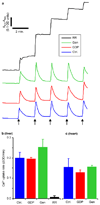UCPs--unlikely calcium porters
- PMID: 18978830
- PMCID: PMC2691551
- DOI: 10.1038/ncb1108-1235
UCPs--unlikely calcium porters
Figures


Comment on
-
Uncoupling proteins 2 and 3 are fundamental for mitochondrial Ca2+ uniport.Nat Cell Biol. 2007 Apr;9(4):445-452. doi: 10.1038/ncb1556. Epub 2007 Mar 11. Nat Cell Biol. 2007. PMID: 17351641 Free PMC article.
References
Publication types
MeSH terms
Substances
Grants and funding
LinkOut - more resources
Full Text Sources

